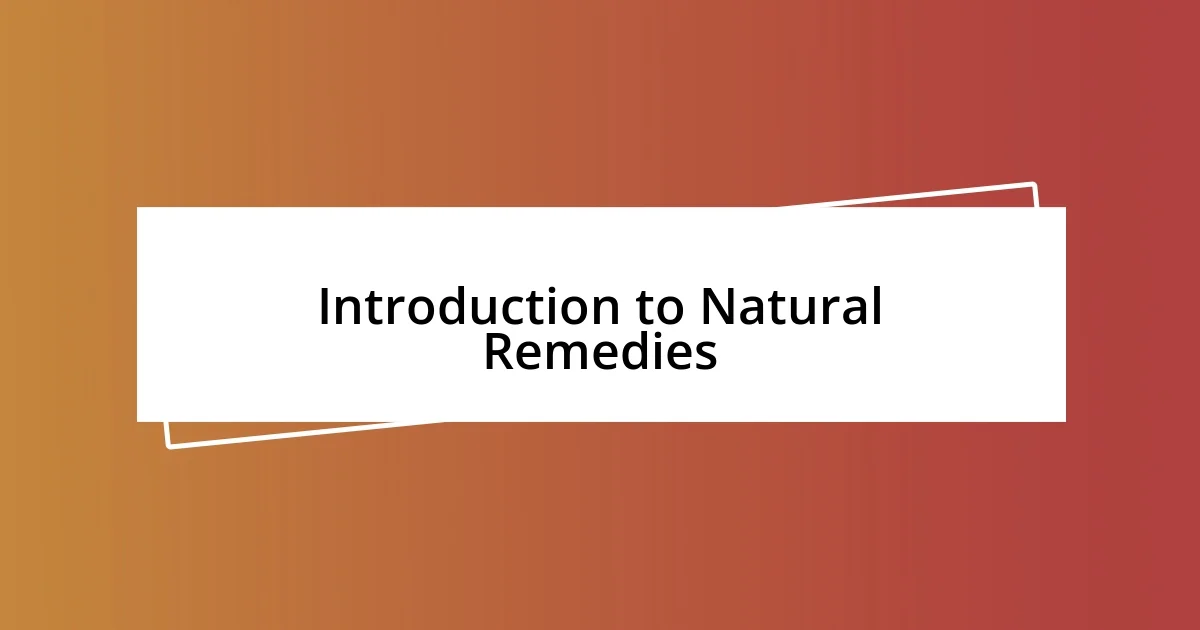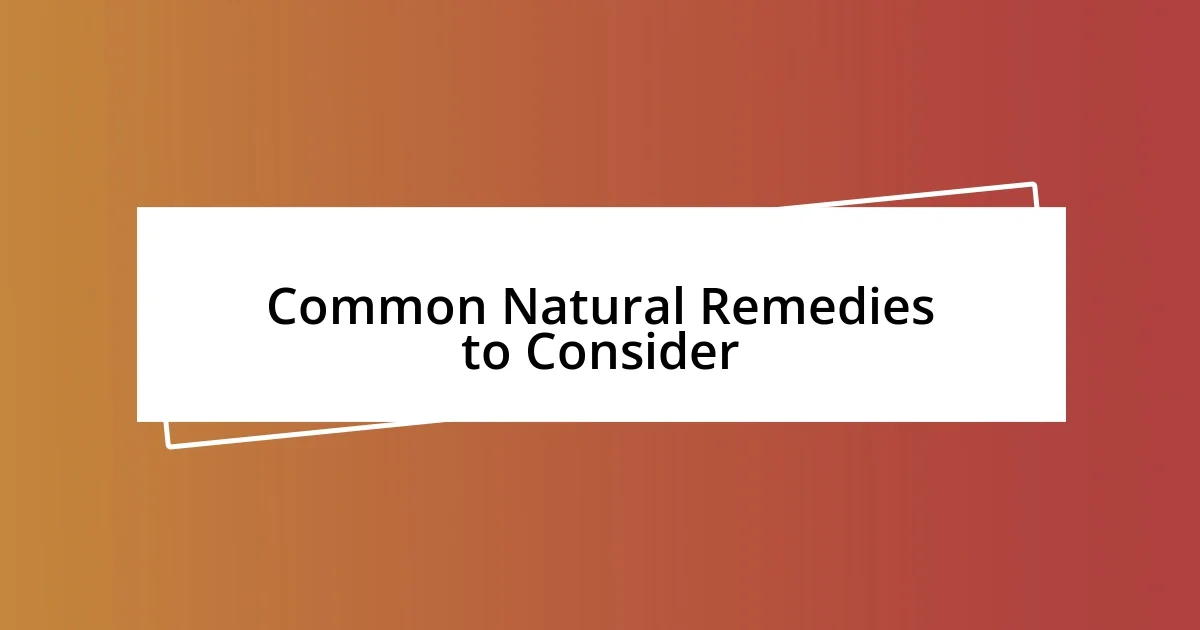Key takeaways:
- Natural remedies are effective and often have fewer side effects compared to conventional medicine, allowing for a holistic approach to wellness.
- Common natural remedies like aloe vera, tea tree oil, chamomile, turmeric, and peppermint provide various health benefits and personal connections that enhance their value.
- Prioritizing safety by starting with small doses, researching potential interactions, and listening to one’s body is crucial when using natural remedies.

Introduction to Natural Remedies
Natural remedies have a long-standing history, deeply rooted in the traditions of various cultures around the world. I remember my grandmother swearing by her herbal teas to soothe everything from a cold to a troubled stomach. It makes me wonder: how did our ancestors discover the power of these simple ingredients?
What’s fascinating to me is how effective nature can be, often with fewer side effects than conventional medicine. For instance, when I decided to try ginger tea for nausea, it worked wonders, reminding me that sometimes the best solutions are right in front of us, waiting to be explored. Isn’t it intriguing how these remedies can evoke both nostalgia and curiosity?
In my journey of discovering natural remedies, I’ve found that they often stem from observing the world around us. Whether it’s the calming effect of lavender or the immune-boosting properties of elderberry, each remedy has its own story. It makes me reflect: what other hidden treasures are out there, just waiting to be uncovered in our everyday lives?

Benefits of Natural Remedies
Natural remedies present a treasure trove of benefits that often surprise me. When I first started using herbal treatments for minor ailments, I was struck by how they not only helped alleviate symptoms but also offered a holistic approach to wellness. It’s like embracing a lifestyle that honors both body and mind, often making me feel more connected to nature.
Here are some benefits that I’ve discovered along the way:
- Fewer Side Effects: Natural remedies often have milder effects compared to pharmaceuticals, which can lead to less disruption in daily life.
- Cost-Effective: Many natural ingredients can be found in your kitchen or local health store, making them budget-friendly options.
- Empowerment: Utilizing remedies allows me to take charge of my health, giving me a sense of control over my well-being.
- Holistic Approach: Remedies often consider the whole person rather than just targeting physical symptoms, addressing emotional and mental wellness too.
- Cultural Connection: Using natural remedies helps me appreciate diverse cultural practices, deepening my understanding of global traditions and approaches to health.
I remember when I used honey and lemon for a sore throat, not only did it soothe the irritation, but it also reminded me of warm afternoons spent baking with my mother. Those personal connections add layers of meaning to each remedy, transforming them from mere solutions into cherished rituals. It’s incredible how natural remedies weave themselves into the fabric of our lives, enriching our experiences in unexpected ways.

Common Natural Remedies to Consider
When exploring common natural remedies, it’s essential to start with some well-known favorites. Aloe vera has been my go-to for sunburn relief. The cooling sensation of its gel not only soothes the skin but also reminds me of lazy summer days spent by the beach, just as the stories of my friends using it for minor cuts and burns showcase its versatility. Then there’s tea tree oil, a powerful antimicrobial agent that I have found effective for occasional breakouts. Just a dab on a blemish often does the trick, evoking memories of my teenage years and the endless battle against acne.
Another remedy I appreciate is chamomile, especially in the form of tea. I often drink it before bed, and I swear by its calming effects. It transforms my evenings into a ritual of relaxation after a hectic day. The aroma itself is like a gentle hug, wrapping me in comfort. There’s also turmeric, which I add to my meals or smoothies for its anti-inflammatory properties. Its vibrant color and earthy flavor not only enrich my dishes but also connect me to a holistic approach that values prevention.
Lastly, I can’t overlook the charm of peppermint. Whether I use peppermint oil for headaches or brew a cup of peppermint tea for digestive relief, it always brings a refreshing perspective. It’s amazing how a simple herb can invigorate my senses and enhance my well-being, often leaving me feeling rejuvenated. Each of these remedies brings not just relief but also stories and experiences that shape my approach to health.
| Remedy | Benefits |
|---|---|
| Aloe Vera | Soothes sunburns and minor skin irritations |
| Tea Tree Oil | Effective for acne and antimicrobial properties |
| Chamomile | Calms and promotes better sleep |
| Turmeric | Anti-inflammatory and antioxidant properties |
| Peppermint | Relieves headaches and aids digestion |

How to Use Herbs Effectively
Using herbs effectively can truly transform your approach to wellness. I’ve found that the way I prepare and consume herbs can make a significant difference. For instance, I’ve learned that brewing fresh herbs into a tea, rather than just sprinkling dried ones in my meals, maximizes their benefits. There’s something really special about sipping a warm cup of ginger tea; the spicy warmth not only comforts me but also helps with digestion, making it a cherished part of my evening routine.
I remember experimenting with herbal infusions, especially when I was feeling a bit under the weather. I combined echinacea and honey in hot water, and the experience was surprisingly soothing. Each sip not only worked to bolster my immune system but also brought a sense of calm. Have you ever tried adding herbs to your bath? A handful of lavender in warm water turned my hectic day into a mini retreat. The aroma was delightful, and it felt like a balm for my spirit, reminding me of summer evenings spent in my grandmother’s garden.
Above all, it’s essential to source quality herbs, ideally organic. I recall a time when I bought some herbs from a local farmer’s market, and I could genuinely taste the difference. They were vibrant and full of life, which truly made the dishes I prepared with them shine. With a little patience and creativity, incorporating herbs into daily life can create moments that are not just healthful but deeply personal and enriching. How do you currently use herbs in your life? Reflecting on this could open up new avenues for your wellness journey!

Safety Tips for Natural Remedies
When delving into natural remedies, I always prioritize safety first. One key tip I can’t stress enough is to start with small doses. I remember the first time I tried ginger for nausea; I added just a pinch to my smoothie. It was a small step, but it made all the difference. Over time, I found my ideal amount, which allowed me to experience its benefits without overwhelming my system.
Another important aspect is to research potential interactions with medications. There was a time when I was really excited about incorporating ginseng into my routine, only to realize it could interfere with my blood pressure medication. This kind of discovery underscored how vital it is to consult healthcare professionals before embracing new herbs or supplements. Have you ever considered how seemingly harmless remedies can impact your overall health? It’s a thought worth pondering.
Lastly, always listen to your body. I’ve learned that what works wonders for one person may not suit another. When I experimented with echinacea last winter, I noticed it made me a bit jittery. Rather than ignoring that feeling, I decided to evaluate my approach. This experience taught me the value of personalizing my wellness journey. Reflecting on how different remedies make you feel can guide you to find what truly resonates with you.

Case Studies on Successful Use
I’ve come across some compelling case studies that perfectly illustrate the power of natural remedies. A friend of mine swears by a regimen of turmeric for inflammation after a knee injury. Initially skeptical, I watched as he went from struggling to walk to jogging regularly within weeks. His journey was a true testament to the healing potential of nature; can you believe that such a vibrant spice could pack such a punch?
There’s also a fascinating case involving chamomile, which is often overlooked. A colleague shared how she struggled with insomnia for years, turning to over-the-counter sleep aids. One evening, she decided to brew a pot of chamomile tea instead. To her surprise, not only did she drift off more easily, but the quality of her sleep improved significantly. It got me thinking—how often do we neglect simple solutions in our quest for quick fixes?
In my own experience, I once witnessed the remarkable effects of peppermint oil for tension headaches during a particularly stressful week. A few drops on my temples seemed almost magical; the fresh scent and cooling sensation helped ease my discomfort. Have you ever considered how a little plant extract could diminish pain? It’s moments like these that remind me how attuned we can become to nature’s gifts when we take the time to explore them.














